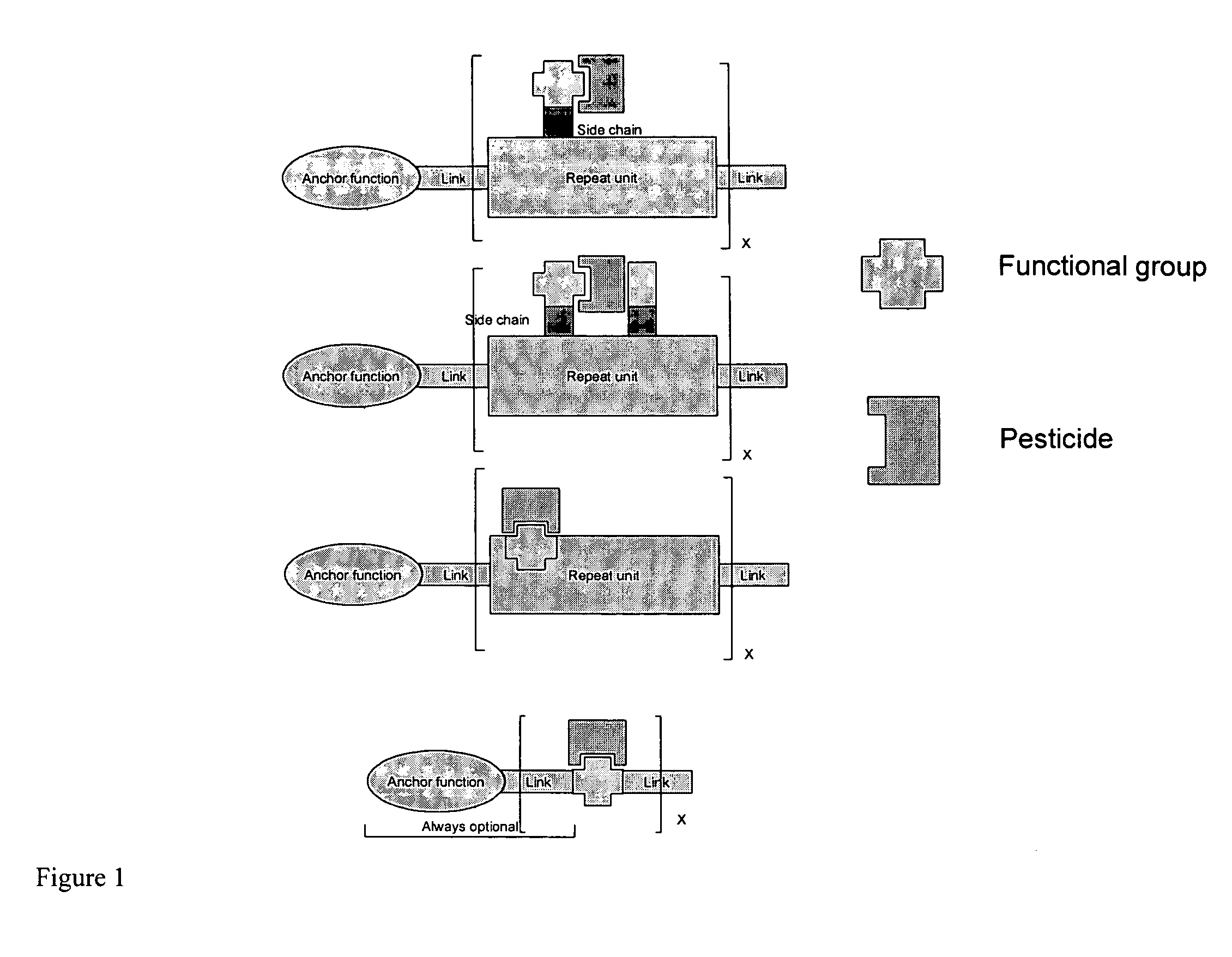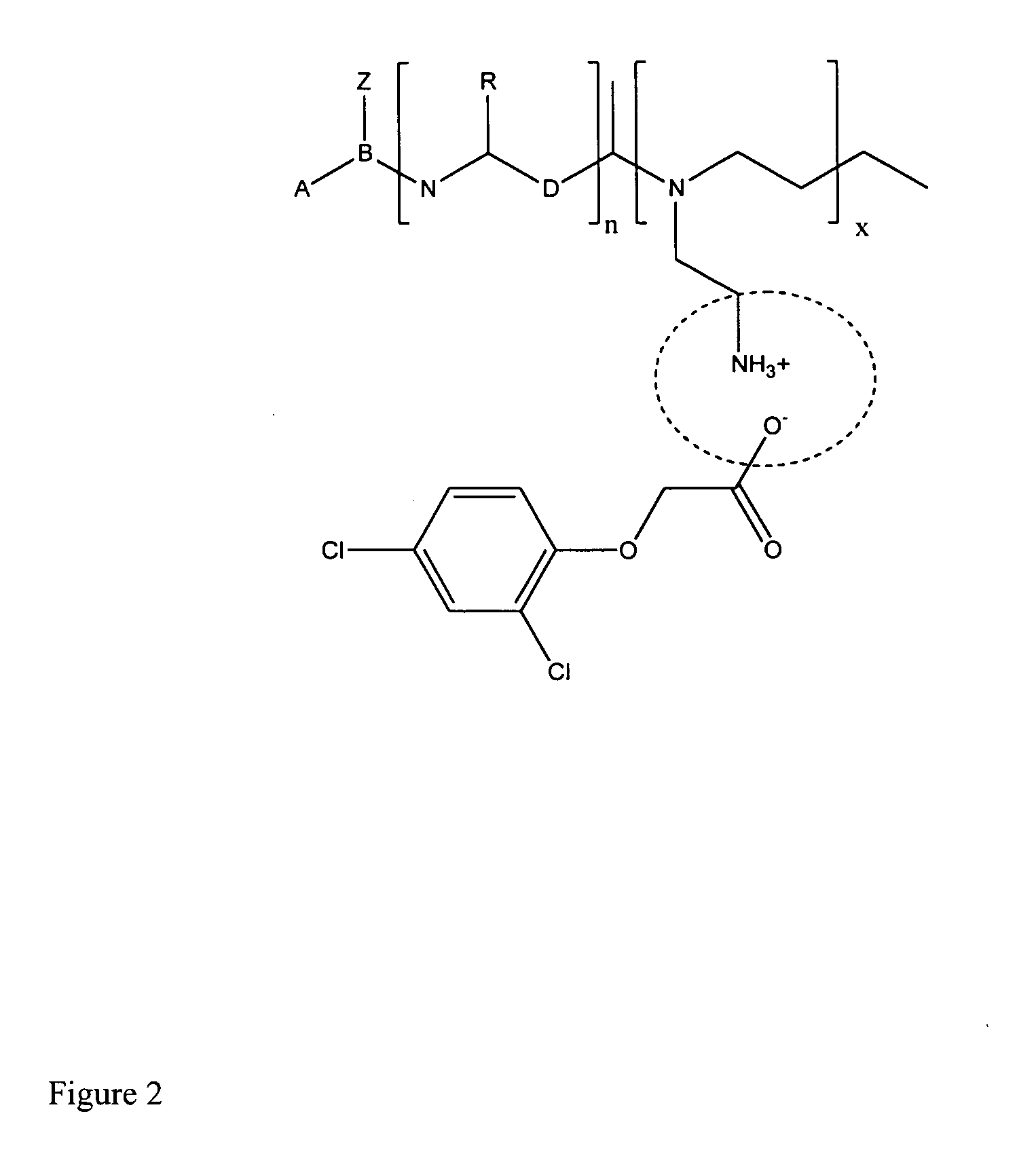Pesticide formulations with substituted biopolymers and organic polymers for improving residual activity, droplet size, adherence and rainfastness on leaves and reduction in soil leaching
a biopolymer and organic polymer technology, applied in the field of pesticide formulations and applications, can solve the problems of less success in controlling the application or placement of pesticides in such a way, undesirable off-target effects, and increase the load on the environment, so as to improve the effect, enhance utility, and negatively buoyant
- Summary
- Abstract
- Description
- Claims
- Application Information
AI Technical Summary
Benefits of technology
Problems solved by technology
Method used
Image
Examples
example 1
Synthesizing Solid Slow Release Cellulose-Based Formulations of Water Soluble, Negatively Charged Fungicides and Insecticides to Solid Anion Exchange Resins
[0079] One hundred grams of dried cellulose powder was reacted with 1 liter epichlorohydrin in 1.2 l of dimethylformamide at 100° C. for 1 h to etherify the cellulose. 400 ml of pyridine was added to the solution and stirring maintained at 100° C. until slight browning of the cellulose is observed. Amine groups were then introduced by adding 1 l of 50% dimethylamine solution. The mixture was stirred for 3 h at 100° C. The reaction product was washed with 20 l of HCl (0.1 M), 20 l of NaOH (0.1 M), and 20 l of 50% aqueous ethanol at 40° C. Yield of the dimethylamine cellulose anion exchanger (DMCAE) was greater than 110% with an exchange capacity of about 3.5 meq / g.
[0080] In this reaction scheme, dimethylamine may be substituted for any of the following: methylamine (33% in ethanol), ethylamine (70% in water), diethylamine (99%),...
example 2
Synthesizing Soluble Slow Release Cellulose-Based Formulations of Water Soluble, Negatively Charged Fungicides and Insecticides to Water-Soluble Anion Exchange Resin
[0082] One hundred grams of dried cellulose powder was reacted with 400 ml of pyridine with continuous stirring for 1 h at 100° C. to open and solubilize the cellulose. Amine groups were then introduced by adding 1 l of 50% dimethylamine solution. The mixture was stirred for 3 h at 100° C. The reaction product was washed with 20 l of NaOH (0.1 M), 20 l of HCl (0.1 M) and 20 l of 50% aqueous ethanol at 40° C. Yield of the dimethylamine cellulose anion exchanger (DMCAE) was about 160% with an exchange capacity of about 3.5 meq / g. A 20 g dry weight equivalents of DMCAE was reacted each with equi-meq amounts of the pyridine, carbamate and benzimidazole type fungicides, respectively cyprodinil, propamocarb, and carbendazim, as well as a similar aliquot was reacted with equi-meq amounts of insecticide thiocyclam, all as a slu...
example 3
Synthesizing Slow Release Formulations of Water Soluble, Negatively Charged Pesticides to Liquid Anion Exchange Resins
[0083] 20 g dry DEAE Dextran C1 form (Batch 99456 mfg 26-3-2003 pK Chemicals A / S, Copenhagen MW 500,000 viscosity 0.5) were dissolved in 50 ml 0.5N NaOH (1 g / 50 ml) and stirred for 30 minutes and dialyzed overnight against water with one change of water. 10 g solid imazapyr acid added in a beaker with sufficient water to allow stirring until fully dissolved. pH measured at 4.5, and left. Dried in vacuum oven at 80 C. Similarly, equi meq amounts of the pyridine, carbamate and benzimidazole type fungicides, respectively cyprodinil, propamocarb, and carbendazim, are reacted with equi-meq amounts of insecticide thiocyclam, all are bound to this matrix in a similar manner.
PUM
 Login to View More
Login to View More Abstract
Description
Claims
Application Information
 Login to View More
Login to View More - R&D
- Intellectual Property
- Life Sciences
- Materials
- Tech Scout
- Unparalleled Data Quality
- Higher Quality Content
- 60% Fewer Hallucinations
Browse by: Latest US Patents, China's latest patents, Technical Efficacy Thesaurus, Application Domain, Technology Topic, Popular Technical Reports.
© 2025 PatSnap. All rights reserved.Legal|Privacy policy|Modern Slavery Act Transparency Statement|Sitemap|About US| Contact US: help@patsnap.com


